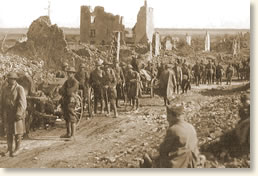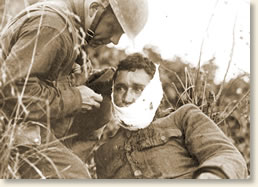|
The Beginning of the
End of World War I, 1918
The complexion of the war in Europe changed dramatically in 1918. With the collapse of the Russian Empire and its subsequent withdrawal from the war (see The
Bolsheviks Storm the Winter Palace, 1917), Germany transferred its troops from the Eastern Front to France. This additional manpower allowed the Germans to mount an attack in the spring of 1918 that converted the static state of trench warfare that had existed on the Western Front since 1914 to a war of movement.
 |
US Infantry passess through the
village of St. Banssant.
September 13, 1918 |
However, the Germans had a problem - they had expended their reservoir of manpower that would supply fresh recruits from the Homeland to the front. They had no reserves to replenish any losses they would incur during their assault. The Germans also had a second problem – the Americans whose recent arrival on the battlefield daily strengthened the Allies with an additional four million troops in action or in training. The German high command hoped to strike a decisive blow before the Americans could get ready for battle. They almost succeeded.
The Germans began their offensive on March 21, 1918 with an attack against British troops. This initial assault was augmented by further attacks all along the Western Front in April, May and June. The British and French troops fell back under the blow. Paris was threatened, but the Germans could not deliver the knock-out punch they strove for.
The final German assault was launched on July 15 with the objective of gaining Paris. General Erich von Ludendorff, commander of the German Army, committed the remainder of his dwindling troops with the hope that, although out-right victory may be beyond their grasp, the capture of the French capital might provide a bargaining chip with which to negotiate an end to the war. In what became known as the Second Battle of the Marne, the French army, augmented by fresh and aggressive American troops, not only resisted the German onslaught but pushed the exhausted Germany army back beyond its starting point. It was the beginning of the end of the First World War.
French and American forces launched a counterattack in the dawning hours of the third day of the German onslaught. Edwin L. James, a reporter for the New York Times, describes the exploits of Sergeant J.F. Brown in the Chateau-Thierry area 50 miles northeast of Paris:
"July 18, 1918
Brown commanded a detachment of eleven men when the German onslaught came. They had shelter, which saved them under the heavy German bombardment, and when the advancing boche came along they let him pass, and then got ready to turn their machine gun loose. But just then a hundred or more Germans came along. Brown ordered his men to scatter quickly. He ducked into the woods, and saw the Huns put his beloved machine gun out of the war. The Germans passed on. Brown looked around and seemed to be alone. He started toward the Marne, away from his own lines, and met his Captain, also alone.
These two Americans, out there in the woods in the dark, the Captain with an automatic pistol and Brown with an automatic rifle saw that the boche barrage kept them from getting to their own lines and so decided to kill all the Germans they could before they themselves were killed. They lay in the thicket while the Germans passed by in large numbers. According to Brown's report, they heard two machine guns going back of them, and decided to go and get them: The two crept close and charged one of the machine guns, which killed the American Captain. Brown got the lone German gunner with his rifle. Then up came an American Corporal, also left alone in the woods, and Brown and the Corporal started after the second German machine gun, behind a clump of bushes.
They got close, and Brown with his automatic rifle killed three Germans, the crew of the gun. Then attracted by the shooting close at hand, up came the eleven men Brown had commanded, each looking for Germans. Brown resumed command, and led the party to where they could see more Germans in a sector of trench taken from the Americans.
These thirteen Americans performed a feat never to be forgotten. The Germans evidently were left in the trenches with machine guns to meet a counter-attack should the Americans make one. Brown posted his twelve men about the Hun position in twelve directions. He took a position where he could rake the trench with his automatic rifle. At a signal the twelve Americans opened up with their rifles from twelve points, and Brown started working his automatic rifle
Brown said he didn't know how many Germans he killed, but fired his rifle until it got so hot he couldn't hold it, and had to rest it across a stump. The Germans then, thinking they were attacked by a large party, decided to surrender. A German Major stepped out of the trench with his hands high, yelling “Kamerad!" Brown laid down his heated rifle, and while three of the hidden Americans guarded him, advanced toward the Major. Then all thirteen Americans moved in and disarmed the Germans. Brown said he didn't know how many there were, but it was more than 100.
Then, with Brown and the Corporal at the head, and the
other eleven Americans in the rear, the procession started through the woods,
guided by a doughboy's compass, toward the American lines. It wasn't plain
sailing. They were behind the German advance, and had to pass it and a space
between the fighting Germans and the Americans. On the way through the woods
several parties of Germans saw the advancing column, with Brown and the Corporal
at its head, and hurriedly surrendered.
 |
A just-wounded American soldier
first aid September 26, 1918
|
Beating through a thicket, Brown led his party to a place where the German advance line was broken. Just as he started over the American lines the Germans laid down a barrage. This got four of the Germans, but didn't touch an American. Brown and his twelve comrades got back with 155 prisoners. The four killed made a total for the thirteen Americans of 159.
American officers were almost dumfounded at the strange tale Brown brought back, but doubt vanished when, soon after he reached regimental headquarters, a military policeman showed up with a large Bundle of maps and plans Brown had taken from dead German officers killed by his automatic rifle, and, handing them to Brown, said: 'Gimme my receipt.'
Brown, who is 23 years old, and last year was a shipping clerk, had met this man on the way back, and, turning over the maps, which made a heavy bundle, had stopped while he scribbled out the receipt he demanded. Meanwhile barrage shells were falling all around. This receipt is part of the records of the American army. . . . "
References:
This eyewitness account was originally published in the New York Times, September 1918, republished in: Hart Albert Bushnell American History Told by Contemporaries v. 5 (1929); Keegan, John, The First World War (1999).
How To Cite This Article:
"The Beginning of the End of World War I, 1918," EyeWitness to History, www.eyewitnesstohistory.com
(2009).
|






